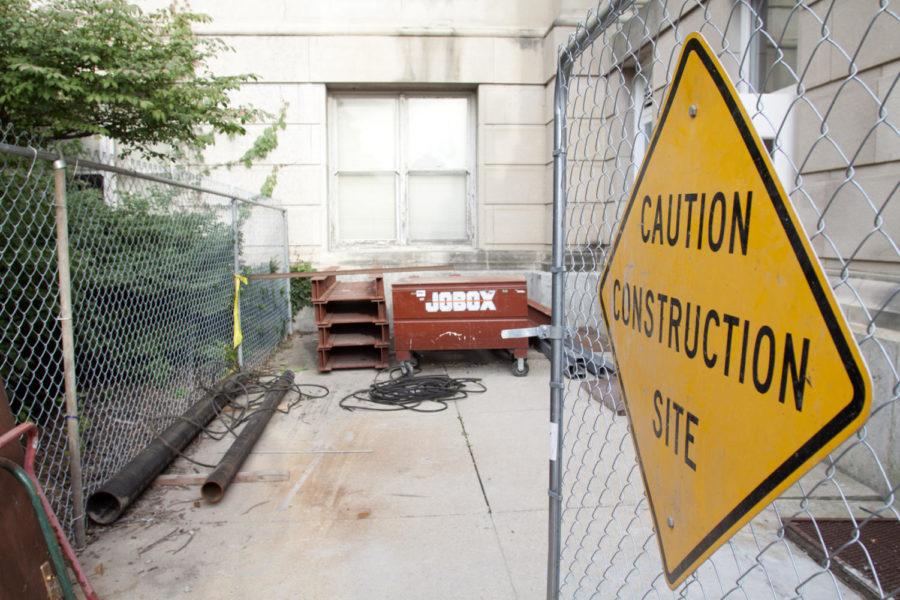First phase of Curtiss Hall renovation nears halfway point
Photo: John Andrus/Iowa State Daily
The lower level of Curtiss Hall is undergoing extensive renovation. The constuction continues on the afternoon of Thursday, Sept. 15.
June 30, 2012
After 100 years of serving thousands of students studying agriculture and life sciences, Curtiss Hall needed a makeover to keep up with the demands of the 21st century.
Planning and fundraising for the $13 million project began in 2008, with construction starting in 2011. After months of renovations, Phase I of the project is nearing at the halfway point. Phase I elements include renovated classrooms, the Monsanto Student Services wing, a new sprinkler system, the Crawford Teaching Complex, remodeled first-floor restrooms, an updated utility infrastructure, the new Harl Commons and accommodating secondary office space moves.
All of these elements are implemented in the renovations with several goals in mind. The project is meant to update the century-old building while still preserving its architectural integrity, improving safety, bringing the building up to code and increasing energy efficiency. The main priority of the project, however, is to create a welcoming environment for students.
David Acker, associate dean for the College of Agriculture and Life Sciences, said the renovation project was an opportunity to show that the college is focused on improving students’ educational experiences. One way to show that students are the top priority is to make Curtiss Hall more student-friendly, Acker said.
Monsanto Student Services Wing
Before the renovation project, students had to travel all over the building to visit offices such as Career Services, Student Services, and Study Abroad. Now, all of these offices and more are conveniently located right next to and across from each other on the ground floor of Curtiss.
The Monsanto Student Services wing is named after the Monsanto Company, which donated $1 million to enhance offices and programs that served students. The concept of the new wing was modeled after a mall, with the idea that students could seamlessly engage in “one-stop shopping” for their needs. The Monsanto Student Services Wing offices include the Welcome Center, College Career Services, Student Services, Marketing and Recruitment, Study Abroad, and Multicultural Student Services.
Windows and utility infrastructure
The university and college provided the funding for most of the windows since the renovation project worked to make the building more energy efficient. It is believed the previous windows in Curtiss were part of the original architecture, making them more than 100 years old. The new windows are more energy efficient and use natural light to brighten the halls on the ground level.
The university and college also provided funding to update the utility infrastructure in order to ensure the safety of students, faculty and staff. The new utility infrastructure includes a new water service, air handler, electrical transformer, emergency generator, smoke evacuation system, sprinkler system and air conditioning throughout the building, thus removing the expensive, inefficient window air conditioning units.
“To me, our responsibility was to get the building ready for the next 100 years,” Acker said.
Harl Commons
Harl Commons is named after Neil and Darlene Harl, who donated $1.5 million to the Curtiss renovations. Harl Commons will be located on the ground level and is intended to be a place for students to meet. Modeled after the Gerdin Business Café, Harl Commons will have plenty of seating for informal gatherings as well as an open meeting space for collaborative projects. There will be a conference room, which students can reserve online, and a computer lab. Food and drinks will be sold in Harl Commons at the Global Café, which will also serve coffee from Uganda. Harl Commons is expected to be completed by Spring 2014.
The future of Curtiss
With Phase I of the renovation project nearly halfway complete, there are hopes for a Phase II project. Acker said even though nothing has been planned or approved for a Phase II project, there is still work to be done. For instance, Phase I of the renovations did not focus on the second and third floors — the project could not financially support total renovations for a building as large as Curtiss simultaneously.
“The renovation project has only been possible because of the commitment of the alumni, of this college and other donors who provided a majority of the funding,” Acker said. “It wouldn’t have been possible if the university wasn’t committed to investing in this college, so it can really look like the leader in the field that it is.”







